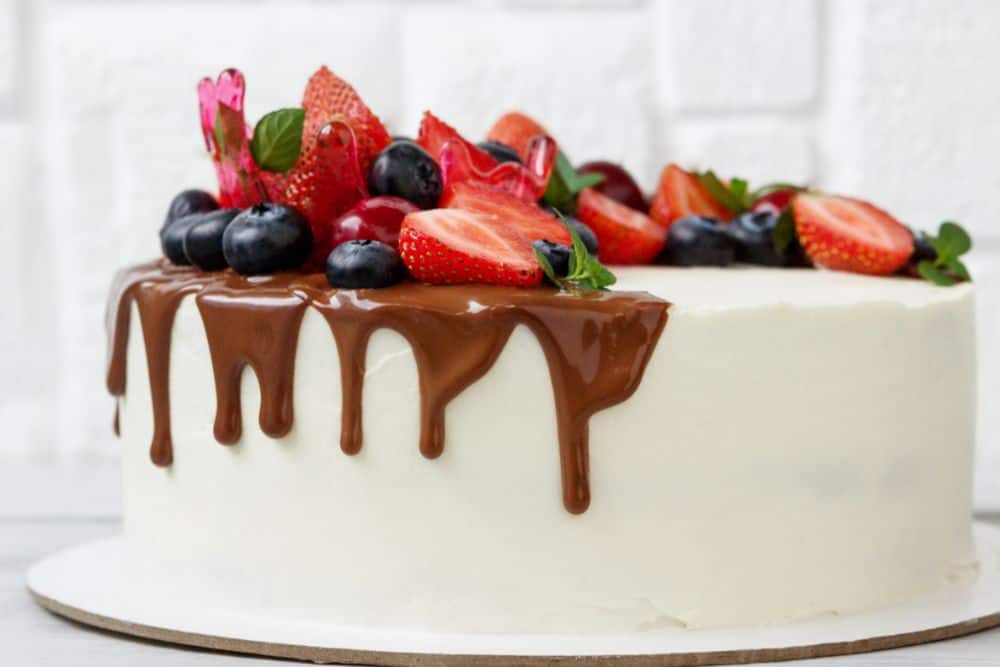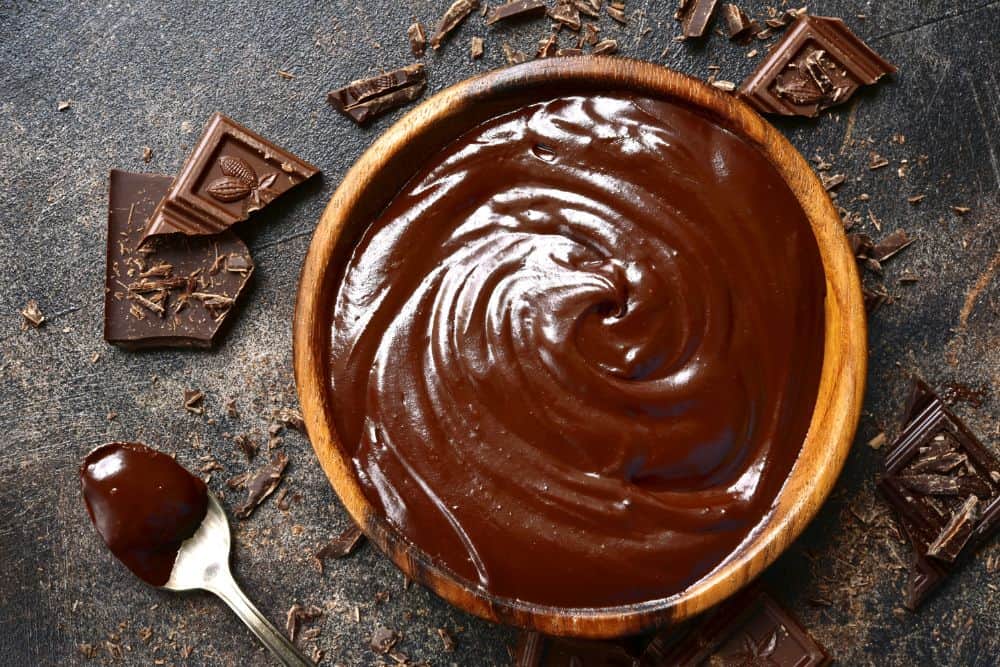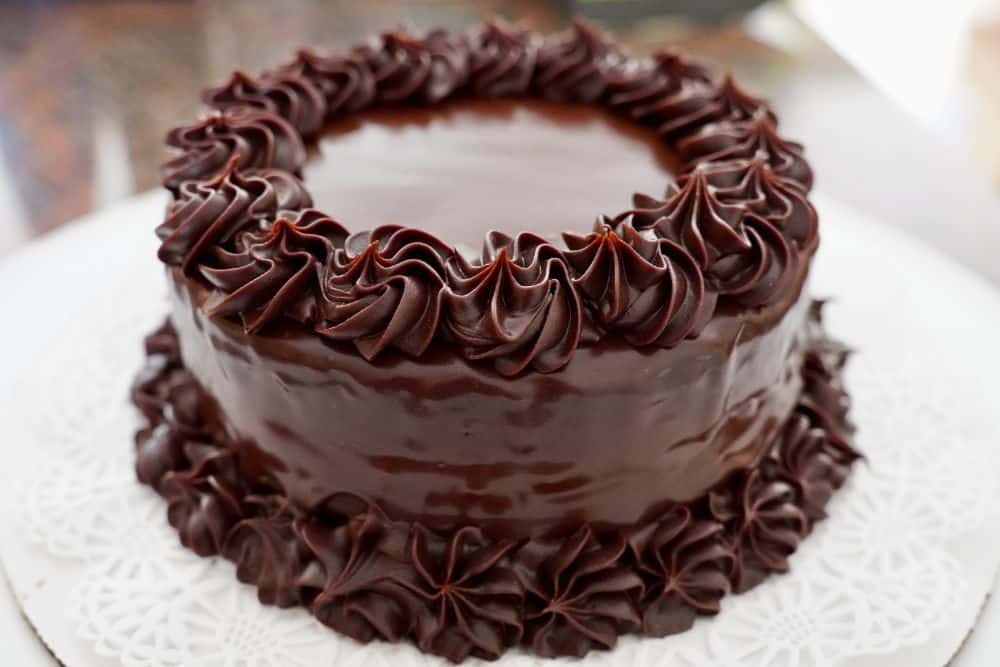Ganache combines chocolate chips or chopped chocolate melted into heavy whipping cream. This rich, chocolatey nectar of the gods is as versatile as it is delicious. It makes a luscious filling for truffles, a fun dessert fondue, a decadent cake frosting, and can even serve as a base for delightful fudge pops.
Ganache is a deceptively simple mixture with many valuable properties. Read on to learn about “does ganache harden?” and many other facts about this culinary wonder.
Ganache does get firmer as it cools, and how strong it gets depends on the mixture's ratio of chocolate to cream. More chocolate will result in a firmer ganache. It will never form a hard shell, but a lovely, firm ganache will make a delightfully fudgy truffle filling or coating on cakes and other pastries.
How long the ganache hardens depends mainly on the temperature it's left standing in. Ganache generally takes 3-4 hours to reach maximum firmness at room temperature. At this point, it should resemble peanut butter in texture. In the fridge, it should firm up in 1-2 hours.

Decorative Ganache on This Cake Will Harden Within a Couple of Hours
Does ganache harden? Yes, it does. So why didn’t yours? The most common reason for the ganache to not harden is too much cream relative to chocolate. The preferred ratio of chocolate to cream will depend on how soft or firm the desired ganache is.
Soft ganache, preferred for sauces and mousses and for whipped frosting and tart filling, needs one part chocolate to two parts cream. Medium ganache, with equal parts cream and chocolate, is best for glazing, fondue, and truffle filling. For thick, fudgy icing, firm ganache is desired, made with two parts chocolate and 1 part cream.
The kind of chocolate used to make the ganache will also affect how firm it will get. Milk chocolate ganache, for example, will never get as strong as dark chocolate ganache; this is due to the presence of milk solids in the composition of the chocolate.
When making ganache with milk chocolate, be sure to use less cream than you would for dark chocolate. White chocolate ganache takes minimal cream to become runny, requiring a ratio of three parts chocolate to one part cream to become reasonably firm.
Ganache is also runny when warm. It must cool to at least room temperature before being used in most culinary applications.
To thicken ganache that is too hot, cool it down. The ganache will generally take 3-4 hours to set when taken off the stove and left at room temperature. Refrigeration can cut this time down to 1-2 hours.

Ganache in a Bowl Before Being Applied to a Cake
It likely needs more chocolate if the ganache still hasn't firmed up sufficiently after cooling down. Reheat your ganache in a double boiler, not too quickly and not too high a temperature, and stir in more chopped chocolate. Please ensure the added chocolate is at least room temperature before mixing it in, or else the ganache will get lumpy.
Another technique you can use to thicken dark or milk chocolate ganache is to add a tiny splash of cream with a lot of cocoa powder. Stirring in some powdered milk may also reduce the bitterness of the resulting ganache.
Other options for thickening runny ganache, at the cost of its pure chocolate flavor, include the addition of almond flour, coconut flakes, or chopped nuts. Corn starch is not recommended, as it needs to be brought up to a simmering temperature to be effective. That would turn the ganache into pudding, at best, and make a grainy ganache at worst.
If that ganache won't firm, no matter what, there is still a bevy of delicious applications. One such application takes advantage of the heavy whipping cream that makes up a good portion of any ganache. Chill the runny ganache. The more liquid it is, the colder it needs to be for this to work. Then take a whisk or electric mixer and beat the ganache until it resembles whipped cream. It can then be served as a pseudo-mousse or piped as whipped frosting.
Another use for runny ganache is as a fudge topping for ice cream or other desserts. It can also serve as a base for hot chocolate or be stirred into pudding mix to add an extra chocolatey flavor. Adding butter to runny ganache will produce a delicious frosting or pastry filling.
The consistency of ganache mainly depends on its recipe's ratio of chocolate to cream. A percentage of two parts chocolate to one part cream will net a firm, peanut butter-like consistency that's great for truffles and icing. Mix equal parts of chocolate and cream to make a silky smooth ganache glaze or fondue. Two parts cream to one part chocolate results in a liquidy, soft ganache. This ganache can be whipped into a faux mousse or spooned into a piping bag as a light frosting.
Now that you know the answer to “does ganache harden?”, let’s dig deeper and learn all about this delicious mix of chocolate and cream.
Ganache is an emulsion. That is a mixture of water and oil where droplets of one are suspended in the other. Specifically, ganache is an oil-in-water emulsion, where droplets of cocoa butter and milk fat are suspended in melted sugar and the liquid of the heavy cream.
How is this possible, given that oil and water don't usually mix? This mixture is due to the presence of chemicals called emulsifiers. In ganache, a protein called casein enables the emulsion. Casein holds the fat and water in cream, and lecithin keeps the oil and water in the chocolate together.
A common mistake when making ganache in many recipe books is to pour the hot cream into a bowl of chopped chocolate and attempt to blend the two. This runs the risk of causing the emulsion to not fully take, leaving tiny unmixed flecks of chocolate in the ganache. Instead, pour chopped or melted chocolate into the hot cream. Alternatively, pour the warm cream into the chocolate and let it sit for a minute. This will gently melt the chocolate, allowing for a smoother mix.
Because there is a mere 20°F between the melting point of chocolate (87-91°F) and its solidifying point (68°F), it's best to melt chocolate gradually using gentle, indirect heat. This is why double boilers are popular in cafes and bakeries. For the same reason, ganache cooled at room temperature is smoother and creamier than ganache cooled in the fridge.
It's best for beginning ganache smiths to use dark or bittersweet chocolate, around 70% cocoa, in their chocolate ganache recipes. That percentage refers to chocolate liquor, a mixture of cocoa solids and cocoa butter. It's what gives chocolate its signature decadent flavor.

Dark Chocolate is an Excellent Choice for Ganache
Dark chocolate supplies a rich, chocolatey flavor for a minimum of fuss. Milk chocolate, by contrast, contains a lot of added sugar and milk solids, meaning that chefs need to carefully adjust the amount of cream they use to consider that. It will also never be as firm as dark chocolate ganache. White chocolate, containing no chocolate liquor, is even more finicky and only recommended for advanced chocolatiers.
Grainy and curdled ganache is a sign that the emulsion has broken. The most common reason for an emulsion break is insufficient liquid to hold all the fat globules in suspension. To fix this, reheat the ganache on a double boiler, whisking vigorously. If the emulsion is still not repaired, stir in a splash of room temperature milk. It may be tempting to use cream but don't, as cream contains a lot of fat and will only worsen a broken emulsion.
Ganache loses its shine as it cools; thus, cooling it at room temperature will have a good chance of preserving its shine. However, ganache left on the counter will gain a matte finish if left overnight. Pour the ganache while it's still warm to keep the glaze shiny. For desserts already chilled, bringing them to room temperature should restore that lovely sheen.
The ganache will also lose its shine if its emulsion fails due to over-whisking or overheating. The ganache will take on a grainy or curdled look when that happens. To fix it, follow the tips detailed above, under "My Ganache Looks Grainy and Curdled, What Do I Do?"
One trick professional bakers use to keep their ganache shiny is adding glucose syrup to their cream as it warms. The ratio they use is about three tablespoons per 100ml of cream. In addition to providing a luminous shine, the glucose syrup helps protect the emulsion and acts as a preservative. If glucose syrup is hard to find, corn syrup, added in the same ratio, should yield a similar result. However, the finished ganache won't set quite as firmly.
Ganache is made from chocolate and heavy cream. Chocolate frosting is made from cocoa powder, milk, butter, and powdered sugar. It also tends to be sweeter than ganache. The frosting is not nearly as versatile as ganache, making fondue or fudge pops with frosting is hard. Still, ganache can substitute for frosting in almost any application.
It is possible to pour ganache over buttercream frosting, but be careful. Both are decadent toppings whose flavors can easily clash or overwhelm the cake. There are a couple of working techniques for applying ganache to buttercream frosting.
For a smooth top layer of ganache with an eye-catching drip effect on the sides, refrigerate your frosted cake for at least an hour, then make the ganache. Let the ganache cool to 85-95°F, then pour the ganache onto the center of the cake. Spread the ganache to the edges with a spatula, turning the cake as you work to ensure that the drips run evenly down the sides of the cake. The ganache should be set after 30 minutes.
For a uniform coat on the cake, refrigerate your cake for an hour and make a double batch of ganache. Once the ganache is cooled to 100°F, pour half of it onto the middle of the cake, using a spatula to spread it. Then run the spatula along the cake's sides to get an even layer. Refrigerate the cake for half an hour while you bring the rest of the ganache to 85-90°F. Pour this ganache over the cake and spread it as you did the first layer.
